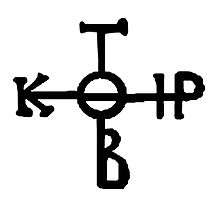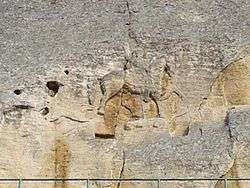Tervel of Bulgaria
| Tervel Тервел | |
|---|---|
| Ruler of Bulgaria | |
|
Modern icon of Khan Tervel[1] | |
| Reign | 700–721 |
| Predecessor | Asparukh |
| Successor | Kormesiy |
| Born | 675 |
| Died | 721 |
| House | Dulo |
| Father | Asparukh |

Khan Tervel (Bulgarian: Тервел) also called Tarvel, or Terval, or Terbelis in some Byzantine sources, was the Khan of Bulgaria during the First Bulgarian Empire at the beginning of the 8th century. In 705 Emperor Justinian II named him Caesar, the first foreigner to receive this title.[1][2] He was probably a Christian like his grandfather Khan Kubrat.[1][3][4] Tervel played an important role in defeating the Arabs during the Siege of Constantinople in 717–718.
The Nominalia of the Bulgarian khans states that Tervel belonged to the Dulo clan and reigned for 21 years. According to the chronology developed by Moskov, Tervel would have reigned 695–715. Other chronologies place his reign in 701–718 or 700–721, but cannot be reconciled with the testimony of the Imennik. The testimony of the source and some later traditions allow identifying Tervel as the son and heir of his predecessor Asparukh, who had perhaps died in battle against the Khazars. The Emperor Tervel is a Bulgarian Saint, painted in many medieval and renaissance frescoes in many churches and monasteries in Bulgaria. [5]
Alliance with Justinian II
Tervel is first mentioned in the Byzantine sources in 704, when he was approached by the deposed and exiled Byzantine emperor Justinian II. Justinian acquired Tervel's support for an attempted restoration to the Byzantine throne in exchange for friendship, gifts, and his daughter in marriage. With an army of 15,000 horsemen provided by Tervel, Justinian suddenly advanced on Constantinople and managed to gain entrance into the city in 705. The restored emperor executed his supplanters, the emperors Leontius and Tiberius III, alongside many of their supporters. Justinian awarded Tervel with many gifts, the title of kaisar (Caesar), which made him second only to the emperor and the first foreign ruler in Byzantine history to receive such a title, and a territorial concession in northeastern Thrace, a region called Zagora. Whether Justinian's daughter Anastasia was married to Tervel as had been arranged is unknown.
_v1.png)
Only three years later, however, when Justinian II consolidated his throne he violated this arrangement and commenced military operations to recover the ceded area but Khan Tervel routed the Byzantines at the Battle of Anchialus (near present-day Pomorie) in 708. In 711, faced by a serious revolt in Asia Minor, Justinian again sought the aid of Tervel, but obtained only lukewarm support manifested in an army of 3,000. Outmaneuvered by the rebel emperor Philippicus, Justinian was captured and executed, while his Bulgarian allies were allowed to retire to their country. Tervel took advantage of the disorders in Byzantium and raided Thrace in 712, plundering as far as the vicinity of Constantinople.
Given the chronological information of the Imennik, Tervel would have died in 715. However, the Byzantine Chronicler Theophanes the Confessor ascribes Tervel a role in an attempt to restore the deposed Emperor Anastasius II in 718 or 719. If Tervel had survived this long, he would have been the Bulgarian ruler who concluded a new treaty (confirming the annual tribute paid by the Byzantines to Bulgaria, the territorial concessions in Thrace, regulating commercial relations and the treating of political refugees) with Emperor Theodosius III in 716. However, elsewhere Theophanes records the name of the Bulgarian ruler who concluded the treaty of 716 as Kormesios, i.e., Tervel's eventual successor Kormesiy. It is probable that the chronicler ascribed the events of 718 or 719 to Tervel simply because this was the last name of a Bulgar ruler that he was familiar with, and that his sources had been silent about the name, as in his account of the siege of Constantinople. According to another theory Kermesios was authorized by Tervel to sign the treaty.
Most researches agree that it was during the time of Tervel when the famous rock relief the Madara Rider was created as a memorial to the victories over the Byzantines, to honour his father Asparukh and as an expression of the glory of the Bulgarian state.
The war with the Arabs in 717–718 and later life

On 25 May 717 Leo III the Isaurian was crowned Emperor of Byzantium. During the summer of the same year the Arabs led by Maslama ibn Abd al-Malik crossed the Dardanelles and besieged Constantinople with a large army and navy.
Leo III made a plea to Tervel for help, relying on the treaty of 716 and Tervel agreed. The first clash between the Bulgarians and the Arabs ended with a Bulgarian victory. During the very first stages of the siege the Bulgarians appeared in the Muslim rear and large part of their army was destroyed and the rest were trapped. The Arabs built two trenches around their camp facing the Bulgarian army and the walls of the city. They persisted with the siege despite the severe winter with 100 days of snowfall. In the spring, the Byzantine navy destroyed the Arab fleets that had arrived with new provisions and equipment, while a Byzantine army defeated Arab reinforcements in Bithynia. Finally, in early summer the Arabs engaged the Bulgarians in battle but suffered a crushing defeat. According to Theophanes the Confessor, the Bulgarians slaughtered some 22,000 Arabs in the battle. Shortly after, the Arabs raised the siege. The Byzantine-Bulgarian victory of 718 and the victory of the Frankish king Charles Martel in the battle of Tours (732) stopped the Muslim advance in the interior of Europe.
In 719 he again interfered in the internal affairs of the Byzantine Empire when the deposed emperor Anastasios II asked for his assistance to regain the throne. Tervel provided him with 360,000 gold coins and sent troops. Anastasios marched to Constantinople, but its population refused to cooperate. In the meantime Leo III sent a letter to Tervel in which he conjured him to respect the treaty and to prefer peace to war. Because Anastasios was abandoned by his supporters, the Bulgarian ruler agreed to the pleas of Leo III and broke relations with the usurper. He also sent to Leo III many of the conspirators who had sought refuge in Pliska.
Legacy
Tervel Peak on Livingston Island in the South Shetland Islands, Antarctica is named after Tervel of Bulgaria.
See also
Notes
- 1 2 3 Свети благоверен цар Български Тривелий - Хан Тервел
- ↑ Хан Тервел - тема за кандидат студенти
- ↑ „История славянобългарска“, св.Паисий Хилендарски, 18 век.
- ↑ "Българите", докум. филм, реж. и сценарист П. Петков, опер. Кр. Михайлов. Производство bTV. 2006 год., България
- ↑ http://gtbyzance.com/articles/The_Bulgarian_Theme_in_Constantinople_Monuments.pdf
References
- Mosko Moskov, Imennik na bălgarskite hanove (novo tălkuvane), Sofia 1988.
- Jordan Andreev, Ivan Lazarov, Plamen Pavlov, Koj koj e v srednovekovna Bălgarija, Sofia 1999.
- (primary source), Bahši Iman, Džagfar Tarihy, vol. III, Orenburg 1997.
- (primary source), Nikephoros Patriarch of Constantinople, Short History, C. Mango, ed., Dumbarton Oaks Texts 10, 1990.
- (primary source), The Chronicle of Theophanes Confessor, C. Mango and R. Scott, trans., Oxford University Press, 1997.
Further reading
External links
| Preceded by Asparukh |
Khan of Bulgaria 695–715 |
Succeeded by Kormesiy |